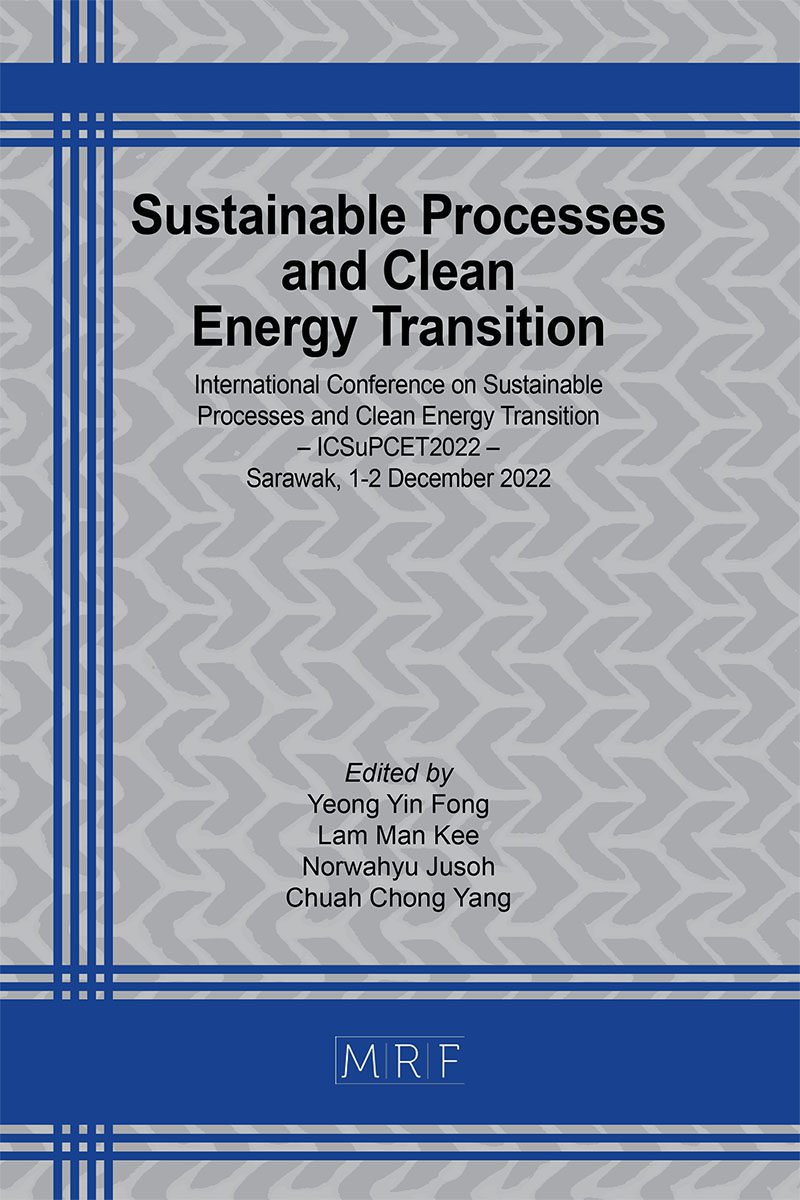Preliminary study of carbon dioxide (CO2) adsorption using chicken eggshell
NOR ADILLA Rashidi, SHARINA NATASHA Sheikh Saghir
download PDFAbstract. Carbon dioxide (CO2) emission is a major concern nowadays due to its contribution to global warming scenarios. Therefore, valorization of inexpensive and green material to adsorb the CO2 prior to emission has been emphasized. In this research study, calcined chicken eggshell waste had been tested as a potential CO2 adsorbent. Specifically, calcined eggshell at 700°C, 800°C, and 900°C has been used in subsequent carbonation reaction at 650°C for 1 hr. The result shows that increasing the calcination temperature improves the eggshell decomposition (weight loss) and CO2 adsorption capacity (weight gain). Specifically, the weight gain by the calcined eggshell at 900°C is roughly 61 wt.%. Both pristine and calcined eggshells are characterized by the Fourier-Transform Infrared Spectroscopy (FTIR), thermogravimetric analysis (TGA), Scanning Electron Microscopy (SEM), and N2 physisorption. Overall, utilization of the chicken eggshell waste is indeed promising as this can contribute to both environmental and economic advantages.
Keywords
Bio-Calcium, Calcination, Carbonation, Carbon Dioxide, Chicken Eggshell
Published online 5/20/2023, 7 pages
Copyright © 2023 by the author(s)
Published under license by Materials Research Forum LLC., Millersville PA, USA
Citation: NOR ADILLA Rashidi, SHARINA NATASHA Sheikh Saghir, Preliminary study of carbon dioxide (CO2) adsorption using chicken eggshell, Materials Research Proceedings, Vol. 29, pp 248-254, 2023
DOI: https://doi.org/10.21741/9781644902516-28
The article was published as article 28 of the book Sustainable Processes and Clean Energy Transition
![]() Content from this work may be used under the terms of the Creative Commons Attribution 3.0 license. Any further distribution of this work must maintain attribution to the author(s) and the title of the work, journal citation and DOI.
Content from this work may be used under the terms of the Creative Commons Attribution 3.0 license. Any further distribution of this work must maintain attribution to the author(s) and the title of the work, journal citation and DOI.
References
[1] M. C. Romano et al., The calcium looping process for low CO2 emission cement and power, Energy Procedia 37 (2013) 7091-7099. https://doi.org/10.1016/j.egypro.2013.06.645
[2] J. Chen, L. Duan, and Z. Sun, Review on the development of sorbents for calcium looping, Energy Fuels 34 (2020) 7806-7836. https://doi.org/10.1021/acs.energyfuels.0c00682
[3] S. Kittipongvises, Assessment of environmental impact of limestone quarrying operations in Thailand, Environ. Clim. Technol. 20 (2017) 67-83. https://doi.org/10.1515/rtuect-2017-0011
[4] H. Ganapathi and M. Phukan, Environmental hazards of limestone mining and adaptive practices for environment management plan, in: R. Singh, P. Shukla, P.Singh (Eds.), Environmental Processes and Management, Springer, Cham, 2020, pp. 121-134. https://doi.org/10.1007/978-3-030-38152-3_8
[5] S. Her, J. Park, P. Li, and S. Bae, Feasibility study on utilization of pulverized eggshell waste as an alternative to limestone in raw materials for Portland cement clinker production, Constr. Build. Mater. 24 (2022) 126589. https://doi.org/10.1016/j.conbuildmat.2022.126589
[6] S. Sethupathi, Y. C. Kai, L. L. Kong, Y. Munusamy, M. J. K. Bashir, and N. Iberahim, “Preliminary study of sulfur dioxide removal using calcined egg shell, Malays. J. Anal. Sci. 21 (2017) 719-725. https://doi.org/10.17576/mjas-2017-2103-21
[7] R. Jayasankar, N. Mahindran, and R. Ilangovan, Studies on concrete using fly ash, rice husk ash and egg shell powder,” Int. J. Civ. Struct. Eng. 1 (2010) 362-372.
[8] A. López-Periago, J. Fraile, P. López-Aranguren, L. Vega, and C. Domingo, CO2 capture efficiency and carbonation/calcination kinetics of micro and nanosized particles of supercritically precipitated calcium carbonate, Chem. Eng. J. 226 (2013) 357-366. https://doi.org/10.1016/j.cej.2013.04.071
[9] A. F. Santos, A. L. Arim, D. V. Lopes, L. M. Gando-Ferreira, and M. J. Quina, Recovery of phosphate from aqueous solutions using calcined eggshell as an eco-friendly adsorbent,” J. Environ. Manag. 238 (2019) 451-459. https://doi.org/10.1016/j.jenvman.2019.03.015
[10] M. Mohamed, S. Yusup, and M. A. Bustam, Synthesis of CaO-based sorbent from biomass for CO2 capture in series of calcination-carbonation cycle, Procedia Eng. vol. 148, pp. 78-85, 2016. https://doi.org/10.1016/j.proeng.2016.06.438
[11] R. Rohim, R. Ahmad, N. Ibrahim, N. Hamidin, and C. Z. A. Abidin, Characterization of calcium oxide catalyst from eggshell waste, Adv Environ Biol. 8 (2014) 35-38.
[12] M.-M. Pedavoah, M. Badu, N. O. Boadi, and J. A. Awudza, Green bio-based CaO from guinea fowl eggshells, Green Sustain. Chem. 8 (2018) 208-219. https://doi.org/10.4236/gsc.2018.82015
[13] Y. Kim, Y. Yoo, M. G. Kim, J.-H. Choi, and K. S. Ryoo, Evaluation of Raw and calcined eggshell for removal of Cd2+ from aqueous solution, J. Korean Chem. Soc. 64 (2020) 249-258.
[14] S. A. Salaudeen, S. H. Tasnim, M. Heidari, B. Acharya, and A. Dutta, Eggshell as a potential CO2 sorbent in the calcium looping gasification of biomass, Waste Manag. 80 (2018) 274-284. https://doi.org/10.1016/j.wasman.2018.09.027
[15] Y. Gao and C. Xu, Synthesis of dimethyl carbonate over waste eggshell catalyst, Catal. Today 190 (2012) 107-111. https://doi.org/10.1016/j.cattod.2011.12.004
[16] R. Mohadi, K. Anggraini, F. Riyanti, and A. Lesbani, Preparation calcium oxide from chicken eggshells, Sri. J. Env. 1 (2016) 32-35. https://doi.org/10.22135/sje.2016.1.2.32-35
[17] A. Commey and M. Mensah, An experimental study on the use of eggshell powder as a pH modifier: Production of lime from eggshells, Int. J. Innov. Sci. Res. Technol. 4 (2019) 766-768.
[18] G. S. Grasa and J. C. Abanades, CO2 capture capacity of CaO in long series of carbonation/calcination cycles, Ind. Eng. Chem. Res. 45 (2006) 8846-8851. https://doi.org/10.1021/ie0606946
[19] A. Borhade and A. Kale, Calcined eggshell as a cost effective material for removal of dyes from aqueous solution, Appl. Water Sci. 7 (2017) 4255-4268. https://doi.org/10.1007/s13201-017-0558-9
[20] T. Witoon, Characterization of calcium oxide derived from waste eggshell and its application as CO2 sorbent, Ceram. Int. 37 (2011) 3291-3298. https://doi.org/10.1016/j.ceramint.2011.05.125
[21] M. A. Al-Ghouti and N. R. Salih, Application of eggshell wastes for boron remediation from water, J. Mol. Liq., 256 (2018) 599-610. https://doi.org/10.1016/j.molliq.2018.02.074
[22] G. V. Sree, P. Nagaraaj, K. Kalanidhi, C. Aswathy, and P. Rajasekaran, Calcium oxide a sustainable photocatalyst derived from eggshell for efficient photo-degradation of organic pollutants, J. Clean. Prod. 70 (2020) 122294. https://doi.org/10.1016/j.jclepro.2020.122294
[23] N. Viriya-empikul, P. Krasae, B. Puttasawat, B. Yoosuk, N. Chollacoop, and K. Faungnawakij, Waste shells of mollusk and egg as biodiesel production catalysts, Bioresour. Technol. 101 (2010) 3765-3767. https://doi.org/10.1016/j.biortech.2009.12.079































